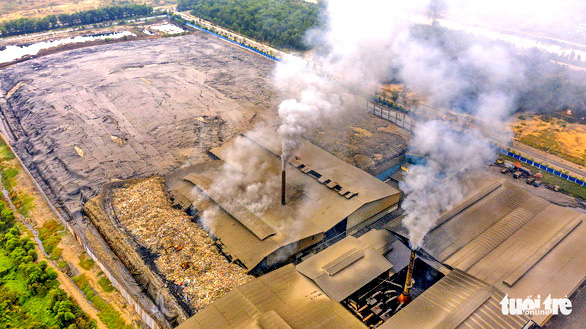Work on three waste-to-energy projects in Ho Chi Minh City started in late 2019 but they have yet to be completed and put into operation.
Meanwhile, the waste volume in the city is increasing and waste is still mainly buried.
Nearly 10,000 metric tons of waste is discharged in Ho Chi Minh City per day and the figure is forecast to rise to 12,500 by 2025.
Nguyen Toan Thang, director of the municipal Department of Natural Resources and Environment, said the city proposed a plan to convert at least 80 percent of that waste into energy.
The three waste-to-energy projects in the city, developed by Vietstar Joint Stock Company, Tam Sinh Nghia Investment-Development Joint Stock Company, and Tasco Joint Stock Company, were expected to be completed by the end of 2020 and treat 6,000 metric tons of waste daily.
However, these plants remain incomplete.
Ngo Nhu Hung Viet, general director of Vietstar Joint Stock Company, said the firm had completed the installation and operation of three waste sorting lines, constructed a 27-meter-wide road leading to the plant, leveled a construction site measuring 45,000 square meters, and signed contracts and made deposits for the main equipment imports.
“We have gotten ready, but the National Power Development Plan VIII has yet to be approved so we have to wait," Viet added.
“The long waiting time may cause some damage to machinery.”
The National Power Development Plan VIII has not been approved as the feasibility of solar power projects and the gas-fired power plant have not been clarified.
The approval delay postponed the execution of many power development projects, according to the National Assembly’s Economic Committee.
Similarly, Tam Sinh Nghia Investment-Development Joint Stock Company and Tasco Joint Stock Company are unable to finish their waste-to-energy plants due to bottlenecks in procedures.
Ho Chi Minh City Urban Environment Company Limited also proposed developing a waste-to-energy plant but the proposal has not been green-lighted.
Sticking to waste burial
Ho Chi Minh City drew up a waste treatment plan for the city until 2025, with a vision toward 2050 because landfills cause groundwater and soil pollution, unpleasant odor, and leachate.
By 2025, the city expects to have recycled and generated electricity from some 80 percent of its waste volume, and gradually put an end to landfills.
Waste in Can Gio District alone will be transported to the Green Environment Technology Park in Thu Thua District, neighboring Long An Province for treatment.
During the period from the formulation of the plan to 2025, the city’s waste will be mainly buried at Da Phuoc Waste Treatment Complex in Binh Chanh District, Tay Bac Solid Waste Treatment Complex in Cu Chi District, and the Green Environment Technology Park.
In the 2025-50 period, waste will be treated at Tay Bac Solid Waste Treatment Complex and the Green Environment Technology Park.
Go Cat and Dong Thanh landfill sites were planned to be renovated to accommodate public facilities and green spaces.
Waste-to-energy projects have been brought to a standstill most likely because of investors’ shortage of orientations, capital, and technical plans, according to Dr. Pham Viet Thuan, director of the Institute of Economics and Environmental Resources.
The absence of a national power development plan is another key reason.
“Therefore, it is difficult to reach the target of running waste-to-energy plants to reduce environmental pollution in the next five years," Thuan said.
“To solve the problems, the city should replace unqualified investors or designate Ho Chi Minh City Urban Environment Company Limited to conduct these projects.
“The city should drastically remove procedures-related obstacles facing enterprises."
Dr. Le Huy Ba, former director of the Institute of Environmental Science, Engineering, and Management, under the Industrial University of Ho Chi Minh City, said, “Ho Chi Minh City has fallen behind in this field.
"We should propose ministries and agencies remove obstacles in administrative procedures to pave the way for the execution of projects.”
Circular waste management needed
Circular-based waste treatment is old but appropriate to such a tropical agricultural country as Vietnam, Dr. Thuan said.
Organic waste accounts for over 65 percent of the total garbage in Vietnam so circular waste treatment is a must.
During the treatment process, bio-catalysts should be used to reduce odor and leachate, and speed up the waste decomposition.
After being treated, organic waste will become humus, which will be used in fertilizer production, thus boosting the development of the agriculture sector as a whole.
Like us on Facebook or follow us on Twitter to get the latest news about Vietnam!




















































